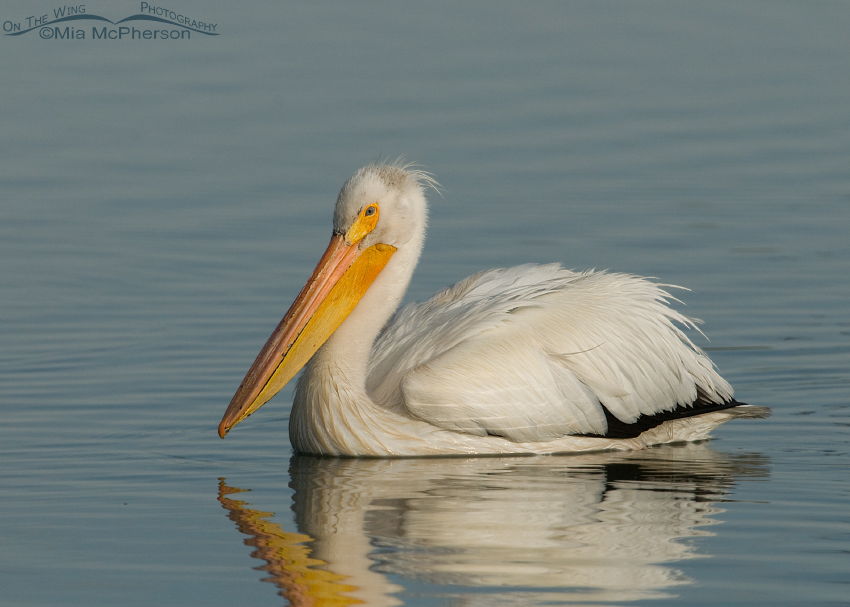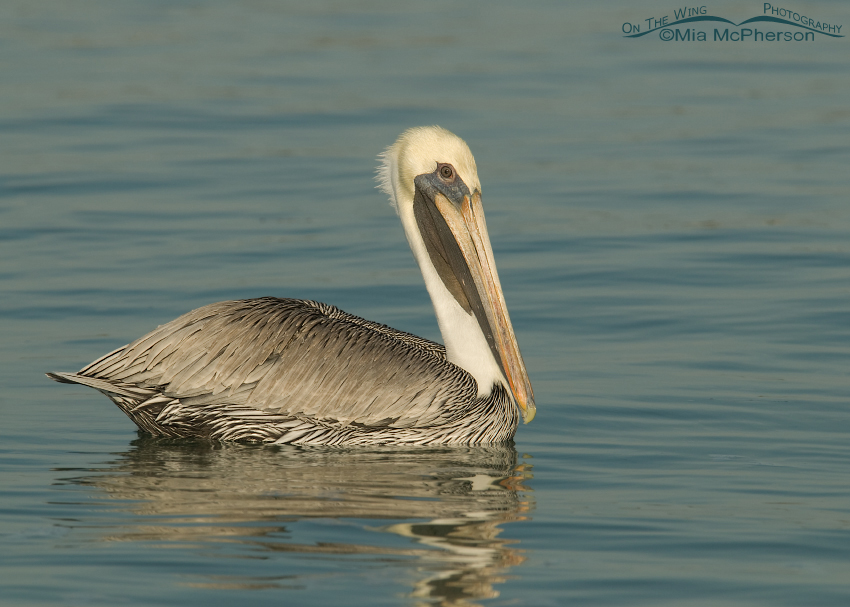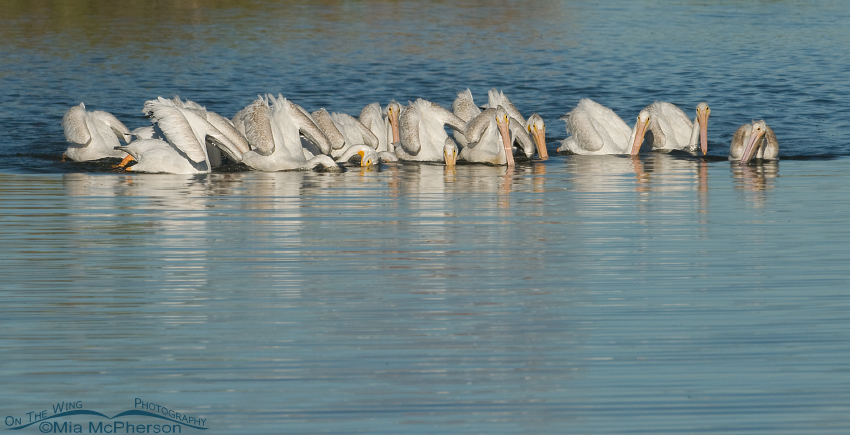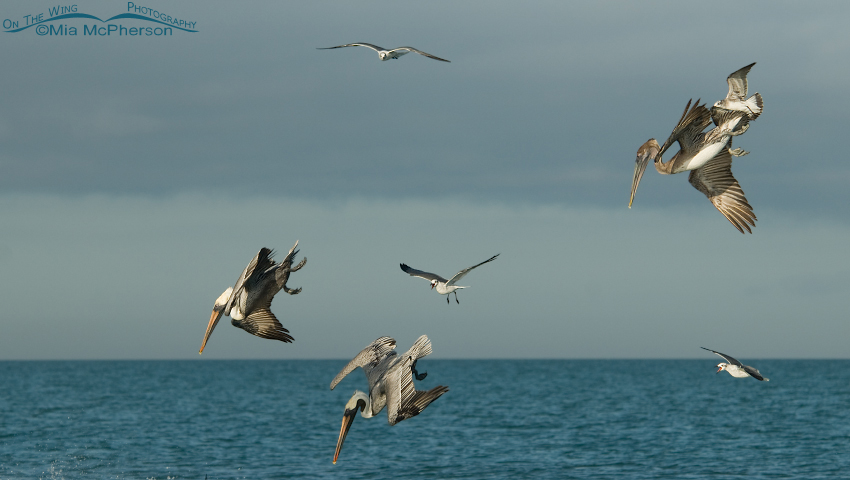 Adult American White Pelican – Nikon D200, f8, 1/1000, ISO 320, +03 EV, Nikkor 200-400mm VR with 1.4x TC at 357mm, natural light
Adult American White Pelican – Nikon D200, f8, 1/1000, ISO 320, +03 EV, Nikkor 200-400mm VR with 1.4x TC at 357mm, natural light
The recent arrival of American White Pelicans to the Salt Lake Valley started me thinking about the differences between Brown Pelicans and American White Pelicans. The obvious difference is the color of these large fish eating birds but there are other differences too. American White Pelicans are larger than Brown Pelicans with a wingspan of up to 108 inches and a weight of around 16.4 pounds. The upper mandible is yellow to pinkish and the pouch is yellow with hints of orange near the base, the bare skin around the eyes is yellow and the legs and feet vary from yellowish green in Definitive Basic plumage to orange-red in Definitive Alternate plumage.
 Adult Brown Pelican in nonbreeding plumage – Nikon D200, handheld, f6.3, 1/1000, ISO 200, Nikkor 80-400mm VR at 280mm, natural light
Adult Brown Pelican in nonbreeding plumage – Nikon D200, handheld, f6.3, 1/1000, ISO 200, Nikkor 80-400mm VR at 280mm, natural light
Brown Pelicans have a wingspan of about 79 inches which is about 2 1/2 feet less than American White Pelicans and Brown Pelicans are also about half the weight of American White Pelicans at approximately 8.2 pounds. The pouch of Atlantic Brown Pelicans is a grayish and during breeding season Pacific Brown Pelicans have a reddish orange pouch closest to the face and grayish green towards the tip of the bill. The feet and legs of Brown Pelicans are gray to black depending on age and season.
 American White Pelicans cooperatively foraging – Nikon D200, f7.1, 1/1600, ISO 400, -03 EV, Nikkor 200-400mm VR with 1.4x TC at 228mm, natural light
American White Pelicans cooperatively foraging – Nikon D200, f7.1, 1/1600, ISO 400, -03 EV, Nikkor 200-400mm VR with 1.4x TC at 228mm, natural light
American White Pelicans forage cooperatively and will often display synchronized movements while foraging. They dip their bills into the water, scoop up the prey into their pouches and then raise their bills horizontally to swallow the prey. They forage from the surface of the water. I often think that their foraging behavior almost like watching a ballet.
 Brown Pelicans plunge-diving – Nikon D200, handheld, f6.3, 1/1000, ISO 200, Nikkor 80-400mm VR at 400mm, natural light
Brown Pelicans plunge-diving – Nikon D200, handheld, f6.3, 1/1000, ISO 200, Nikkor 80-400mm VR at 400mm, natural light
Brown Pelicans plunge dive for their prey and it can look quite dramatic at times. They fly over the prey, fold their wings and plunge head first into the water. They then surface with their bills close to their bodies and allow the water to drain out of the pouch then they swallow their prey with a toss of their heads. I once saw a Brown Pelican swallow a small shark in one gulp. Brown Pelicans; including Peruvian Pelicans, are the only pelicans to feed using the plunge-dive method. Watching a squadron of a hundred or more Brown Pelicans plunge diving is exciting!
There are of course other differences that I haven’t mentioned but I think I have covered the basics.
I find comparing American White Pelicans to Brown Pelicans to be interesting because they are excellent subjects to observe and photograph.
Mia
PS: There are a few records of Brown Pelicans in Utah, the most recent sightings were in May of 2004. (More recently a long staying Brown Pelican was at Bear River MBR in the summer of 2019)
Click here to see more of my American White Pelican photos and here for my Brown Pelican photos. Each page has facts and information about the individual species.
The American White Pelicans were photographed in Utah, the single bird in Salt Lake County and the foraging pelicans at Farmington Bay WMA. The Brown Pelicans were photographed at Fort De Soto County Park in Florida.


It’s so interesting how different the feeding techniques of these two species are. I love watching both of them! Your capture of the diving pelicans is awesome!
Spectacular images!! Every one!!!!
Thank you. For the information, and for the images.
And for the picture in my head of ‘birdy ballet’. Love it.
Mia, thanks for this comparison and contrast of these incredible species. Pelicans touch my heart in a big way. They represent home (California) and there is something in their countenance that always brings me peace. I miss seeing them in Seattle. I find both of these fishing behaviors fascinating, and am drawn to the White Pelican methodology of cooperative fishing just because I haven’t seen it quite as often. That being said, Brown Pelicans are so dramatic in their delivery! They defy the clunkiness of their physiology to exist with grace, both in the air and in the water. Lovely post!
Another enjoyable and educational post. The last time I went to Florida, a brown pelican on the pier let me get very close to take a photo.
Interesting information…wish I’d known it when we lived in South Miami…love this series of images. One of my sisters lives on Bald Head Island, off of the North Carolina coast, and sees dolphins arcing through the water and squadrons of brown pelicans divin for fish all the time
Nice job pointing out the features of both species. I love watching them!
Great post!
Thank you for the lesson on the differences and the photographs, as usual, are stunning!
Superb action shot of the diving Pelicans.
Beautiful photos, thank you! I really like this birds
Brilliant images of the Pelicans, great photos.